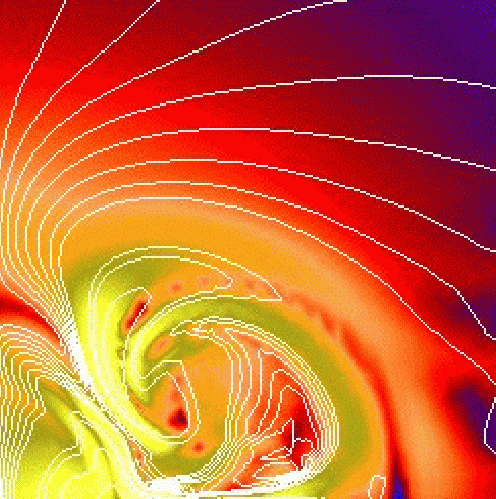| MPA-HOMEPAGE |
|
 |
Simulations of Magnetorotational Supernova Core Collapse in Newtonian and Relativistic Gravity | ||
|
|
 Go to:
|
M.A. Aloy ( P. Cerdá-Durán H. Dimmelmeier ( J.A. Font ( E. Müller M. Obergaulinger  Introduction:
Introduction:
Neutron stars have intense or (in the case of magnetars) even extremely strong magnetic fields, which they must have acquired at some point during their lifetime. The seed for their magnetic field was laid already at their time of birth, when they formed as a proto-neutron star from a gravitationally collapsing stellar core in a supernova event. Later, as the proto-neutron star cools down and shrinks to the final neutron star, and evolves as a cold rotating neutron star, the field also undergoes an evolution and can possibly change both in strength and topology. The dynamic emergence of a neutron star's magnetic field from the initial field configuration in the pre-collapse stellar core, and the impact on gravitational wave emission from core collapse or neutron star pulsations is an active and important field of research. If the magnetic field is sufficiently strong, it can influence the collapse dynamics itself, it can alter the neutron star's shape, and it can also shift the frequencies of pulsations that may be excited in the (proto-) neutron star by various mechanisms. 
Fully dynamic simulations of the effects of magnetic field on the
birth of a proto-neutron star in a supernova collapse have become
feasible only very recently. Starting with a Newtonian code in
[Obergaulinger, et al., 2006a]
we have simulated several of our previous Our studies show that during the very dynamics collapse phase, when the stellar core (which weighs more than one solar mass) contracts in radius from about 1000 to 10 km and increases its central density by more than four orders of magnitude, magnetic fields can only impact the collapse noticeably if they were already extremely strong in the initial pre-collapse core, which is astrophysically very unlikely. For weak initial fields (which is the astrophysically best motivated case) there are no differences compared to purely hydrodynamic simulations without magnetic fields, neither in the collapse dynamics nor in the resulting gravitational wave signal.
In addition to that Newtonian study, which was based on a simple
description of matter, recently we have presented the first general
relativistic simulations of rotational supernova core collapse
with models using a microphysical equation of state and including
magnetic fields [Cerdá-Durán, et al., 2007]
(repeating some of the
As expected, the results again indicate that for astrophysically motivated field strengths the magnetic field will not affect the gravitational wave emission in the collapse and early post-bounce phase, while it may become important at later post-bounce times due to various dynamo mechanisms and the prospective magneto-rotational instability. Such simulations are the first step to explaining in detail how and at what stage magnetars obtain their extremely strong magnetic fields.
|